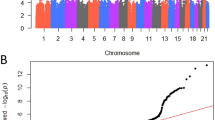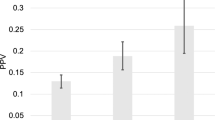Abstract
Background:
Both genetics and the environment are implicated as risk factors for prostate cancer (PCa). This population-based case–control study evaluated four single-nucleotide polymorphisms (SNPs) previously identified by genome-wide association studies to be associated with increased PCa susceptibility. Potential relationships between serum concentrations of phyto-estrogens and SNPs were also investigated.
Methods:
Four SNPs (rs10993994, rs2660753, rs1016343 and rs6983267) were genotyped in 247 PCa patients, 125 BPH patients and 274 control men recruited in Scotland. Serum concentrations of the phyto-estrogens enterolactone, equol, genistein and daidzein were measured by isotope dilution gas chromatography–mass spectrometry.
Results:
Increased PCa risk was associated with TT genotype of rs10993994 compared with CC and CT genotypes combined (odds ratio (OR)=1.87; 95% confidence interval (CI), 1.26–2.77). TT homozygotes who had low serum enterolactone concentrations (below median) were more likely to have PCa (OR=2.90; 95% CI, 1.28–6.57) than individuals with CC/CT genotype and high serum enterolactone concentrations (above median). PCa was not associated with the other three SNPs tested.
Conclusions:
PCa susceptibility was associated with TT genotype of SNP rs10993994 in this cohort of Scottish men and the increased risk of PCa was modified by serum enterolactone concentrations.
This is a preview of subscription content, access via your institution
Access options
Subscribe to this journal
Receive 4 print issues and online access
$259.00 per year
only $64.75 per issue
Buy this article
- Purchase on Springer Link
- Instant access to full article PDF
Prices may be subject to local taxes which are calculated during checkout
Similar content being viewed by others
References
ISD Scotland. Cancer in Scotland. 2011; Available from: http://www.isdscotland.org. (cited 19 February 2012).
Cancer Research UK. Cancer incidence for common cancers. 2008; Available from: www.cancerresearchuk.org. (cited 19 February 2012).
Johns LE, Houlston RS . A systematic review and meta-analysis of familial prostate cancer risk. BJU Int 2003; 91: 789–794.
Eeles RA, Kote-Jarai Z, Giles GG, Olama AA, Guy M, Jugurnauth SK et al. Multiple newly identified loci associated with prostate cancer susceptibility. Nat Genet 2008; 40: 316–321.
Al Olama AA, Kote-Jarai Z, Giles GG, Guy M, Morrison J, Severi G et al. Multiple loci on 8q24 associated with prostate cancer susceptibility. Nat Genet 2009; 41: 1058–1060.
Yeager M, Chatterjee N, Ciampa J, Jacobs KB, Gonzalez-Bosquet J, Hayes RB et al. Identification of a new prostate cancer susceptibility locus on chromosome 8q24. Nat Genet 2009; 41: 1055–1057.
Gudmundsson J, Sulem P, Manolescu A, Amundadottir LT, Gudbjartsson D, Helgason A et al. Genome-wide association study identifies a second prostate cancer susceptibility variant at 8q24. Nat Genet 2007; 39: 631–637.
Cook LS, Goldoft M, Schwartz SM, Weiss NS . Incidence of adenocarcinoma of the prostate in Asian immigrants to the United States and their descendants. J Urol 1999; 161: 152–155.
Travis RC, Spencer EA, Allen NE, Appleby PN, Roddam AW, Overvad K et al. Plasma phyto-oestrogens and prostate cancer in the European Prospective Investigation into Cancer and Nutrition. Br J Cancer 2009; 100: 1817–1823.
Heald CL, Ritchie MR, Bolton-Smith C, Morton MS, Alexander FE . Phyto-oestrogens and risk of prostate cancer in Scottish men. Br J Nutr 2007; 98: 388–396.
Ho CK, Anwar S, Nanda J, Habib FK . FGFR4 Gly388Arg polymorphism and prostate cancer risk in Scottish men. Prostate Cancer Prostatic Dis 2010; 13: 94–96.
Liu H, Wang B, Han C . Meta-analysis of genome-wide and replication association studies on prostate cancer. Prostate 2011; 71: 209–224.
Morton MS, Wilcox G, Wahlqvist ML, Griffiths K . Determination of lignans and isoflavonoids in human female plasma following dietary supplementation. J Endocrinol 1994; 142: 251–259.
Morton MS, Arisaka O, Miyake N, Morgan LD, Evans BA . Phytoestrogen concentrations in serum from Japanese men and women over forty years of age. J Nutr 2002; 132: 3168–3171.
Bland JM, Altman DG . Statistics notes. The odds ratio. BMJ 2000; 320: 1468.
Batra J, Lose F, Chambers S, Gardiner RA, Aitken J, Yaxley J et al. A replication study examining novel common single nucleotide polymorphisms identified through a prostate cancer genome-wide association study in a Japanese population. Am J Epidemiol 2011; 174: 1391–1395.
Yamada H, Penney KL, Takahashi H, Katoh T, Yamano Y, Yamakado M et al. Replication of prostate cancer risk loci in a Japanese case-control association study. J Natl Cancer Inst 2009; 101: 1330–1336.
Camp NJ, Farnham JM, Wong J, Christensen GB, Thomas A, Cannon-Albright LA . Replication of the 10q11 and Xp11 prostate cancer risk variants: results from a Utah pedigree-based study. Cancer Epidemiol Biomarkers Prev 2009; 18: 1290–1294.
Thomas G, Jacobs KB, Yeager M, Kraft P, Wacholder S, Orr N et al. Multiple loci identified in a genome-wide association study of prostate cancer. Nat Genet 2008; 40: 310–315.
Lange EM, Salinas CA, Zuhlke KA, Ray AM, Wang Y, Lu Y et al. Early onset prostate cancer has a significant genetic component. Prostate 2012; 72: 147–156.
Chang BL, Spangler E, Gallagher S, Haiman CA, Henderson B, Isaacs W et al. Validation of genome-wide prostate cancer associations in men of African descent. Cancer Epidemiol Biomarkers Prev 2011; 20: 23–32.
Lou H, Yeager M, Li H, Bosquet JG, Hayes RB, Orr N et al. Fine mapping and functional analysis of a common variant in MSMB on chromosome 10q11.2 associated with prostate cancer susceptibility. Proc Natl Acad Sci USA 2009; 106: 7933–7938.
Pomerantz MM, Shrestha Y, Flavin RJ, Regan MM, Penney KL, Mucci LA et al. Analysis of the 10q11 cancer risk locus implicates MSMB and NCOA4 in human prostate tumorigenesis. PLoS Genet 2010; 6: e1001204.
Whitaker HC, Kote-Jarai Z, Ross-Adams H, Warren AY, Burge J, George A et al. The rs10993994 risk allele for prostate cancer results in clinically relevant changes in microseminoprotein-beta expression in tissue and urine. PLoS One 2010; 5: e13363.
Xu B, Wang J, Tong N, Mi Y, Min Z, Tao J et al. A functional polymorphism in MSMB gene promoter is associated with prostate cancer risk and serum MSMB expression. Prostate 2010; 70: 1146–1152.
Nolet S, Mbikay M, Chretien M . Prostatic secretory protein PSP94: gene organization and promoter sequence in rhesus monkey and human. Biochim Biophys Acta 1991; 1089: 247–249.
Levy N, Paruthiyil S, Zhao X, Vivar OI, Saunier EF, Griffin C et al. Unliganded estrogen receptor-beta regulation of genes is inhibited by tamoxifen. Mol Cell Endocrinol 2010; 315: 201–207.
Shanle EK, Xu W . Endocrine disrupting chemicals targeting estrogen receptor signaling: identification and mechanisms of action. Chem Res Toxicol 2011; 24: 6–19.
Fraser GE, Franke AA, Jaceldo-Siegl K, Bennett H . Reliability of serum and urinary isoflavone estimates. Biomarkers 2010; 15: 135–139.
Sonestedt E, Ericson U, Gullberg B, Penalvo JL, Adlercreutz H, Wirfalt E . Variation in fasting and non-fasting serum enterolactone concentrations in women of the Malmo Diet and Cancer cohort. Eur J Clin Nutr 2008; 62: 1005–1009.
Acknowledgements
This study was funded by Cancer Research UK and NHS Highland Endowment Fund.
Author information
Authors and Affiliations
Corresponding author
Ethics declarations
Competing interests
The authors declare no conflict of interest.
Additional information
Supplementary Information accompanies the paper on the Prostate Cancer and Prostatic Diseases website
Supplementary information
Rights and permissions
About this article
Cite this article
Ho, C., Halley, L., Wei, J. et al. Analysis of prostate cancer association with four single-nucleotide polymorphisms from genome-wide studies and serum phyto-estrogen concentrations. Prostate Cancer Prostatic Dis 15, 365–368 (2012). https://doi.org/10.1038/pcan.2012.24
Received:
Revised:
Accepted:
Published:
Issue Date:
DOI: https://doi.org/10.1038/pcan.2012.24



